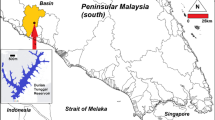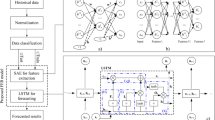Abstract
Inflow forecasting applies data supports for the operations and managements of reservoirs. To better accommodate the sophisticated characteristics of the daily reservoir inflow, two deep feature learning architectures, i.e., deep restricted Boltzmann machine (DRBM) and stack Autoencoder (SAE), respectively, are introduced in this paper. This study sheds light on the application of deep learning architectures for daily reservoir inflow forecasting, which has been attracting much attention in various areas for its ability to extract and learn useful features from a large number of data. Evaluations are made comparing the basic feed forward neural network (FFNN), the autoregressive integrated moving average (ARIMA), and two categories deep neural networks (DNNs) constructed by the integrations the FFNN with two deep feature learning architectures, named DRBM-based NN and stack SAE-based NN, respectively. Two daily inflow series of the Three Gorges reservoir (1/1/2000–31/12/2014) and the Gezhouba reservoir (1/1/1992–31/12/2014), China, are applied for four modeling exercises, respectively. The results show that, the two DNN models overwhelm the FFNN and the ARIMA models in terms of mean absolute percentage error, normalized root-mean-square error, and threshold statistic criteria.









Similar content being viewed by others
References
Awan JA, Bae DH (2014) Improving ANFIS based model for long-term dam inflow prediction by incorporating monthly rainfall forecasts. Water Resour Manag 28(5):1185–1199
Bai Y, Chen ZQ, Xie JJ, Li C (2016a) Daily reservoir inflow forecasting using multiscale deep feature learning with hybrid models. J Hydrol 532:193–206
Bai Y, Xie JJ, Wang XX, Li C (2016b) Model fusion approach for monthly reservoir inflow forecasting. J Hydroinf 18(4):634–650
Bengio Y (2009) Learning deep architectures for AI. Found Trends Mach Learn 2:1–55
Bengio Y, Lamblin P, Popovici D, Larochelle H (2007) Greedy layer-wise training of deep networks. Adv Neural Inf Proces Syst 19:153–160
Bengio Y, Courville A, Vincent P (2014) Unsupervised feature learning and deep learning: a review and new perspectives. Cornell University Library, arXiv: 1206.5538v3
Box GEP, Jenkins GM, Reinsel GC (2013) Time series analysis: forecasting and control. Wiley, Hoboken, NJ
Chen JF, Jin QJ, Chao J (2012) Design of deep belief networks for short-term prediction of drought index using data in the Huaihe River Basin. Math Probl Eng 46(2):243–253
Cho KH, Ilin A, Raiko T (2011) Improved learning of Gaussian-Bernoulli restricted Boltzmann machines. Lect Notes Comput Sci 6791:10–17
El-Shafie A, Noureldin A (2011) Generalized versus non-generalized neural network model for multi-lead inflow forecasting at Aswan High Dam. Hydrol Earth Syst Sci 15(3):841–858
Erhan D, Manzagol PA, Bengio Y, Bengio S, Vincent P (2009) The difficulty of training deep architectures and the effect of unsupervised pretraining. Immunol Fungal Infect 5:153–160
Erhan D, Bengio Y, Courville A, Manzagol PA, Vincent P, Bengio S (2010) Why does unsupervised pre-training help deep learning? J Mach Learn Res 11:625–660
Farias CASD, Kadota A, Celeste AB, Suzuki K (2007) RNN-based inflow forecasting applied to reservoir operation via implicit stochastic optimization. Proc. Symp. Quantification Reduction Predictive Uncertainty Sustainable Water Resour. Manage., Perugia, Italy, 452–462
Glauner PO (2015) Comparison of training methods for deep neural networks. Imperial College London, arXiv: 1504.06825v1
Guo J, Huang W, Song H, Xie K (2014) Deep architecture for traffic flow prediction: Deep belief networks with multitask learning. IEEE Trans Intell Transp Syst 15:2191–2201
Hinton GE (2002) Training products of experts by minimizing contrastive divergence. Neural Comput 14(8):1771–1800
Hinton GE, Osindero S, Teh YW (2006) A fast learning algorithm for deep belief nets. Neural Comput 18(7):1527–1554
Huang CH, Zhong L, Huang YH, Zhang G, Zhong XL (2015) A novel method for text recognition in natural scene based on sparse stacked Autoencoder. J Comput Inf Syst 11(4):1399–1406
Kisi O (2015) Streamflow forecasting and estimation using least square support vector regression and adaptive neuro-fuzzy embedded fuzzy c-means clustering. Water Resour Manag 29(14):1–19
Kumar S, Tiwari MK, Chatterjee C, Mishra A (2015) Reservoir inflow forecasting using ensemble models based on neural networks, wavelet analysis and bootstrap method. Water Resour Manag 29(13):4863–4883
Lalis JT, Gerardo BD, Byun Y (2014) An adaptive stopping creterion for backpropagetion learning in feedforward neural network. Int J Multimed Ubiquit Eng 9:149–156
Längkvist M, Karlsson L, Loutfi A (2014) A review of unsupervised feature learning and deep learning for time-series modeling. Pattern Recogn Lett 42(6):11–24
Li C, Sanchez R, Zurita G, Cerrada M, Cabrera D, Vásquez R (2015) Multimodal deep support vector classification with homologous features and its application to gearbox fault diagnosis. Neurocomput 168:119–127
Li C, Sanchez R, Zurita G, Cerrada M, Cabrera D, Vásquez R (2016) Gearbox fault diagnosis based on deep random forest fusion of acoustic and vibratory signals. Mech Syst Signal Process 76–77:283–293
Lin GF, Wu MC, Chen GR, Tsai FY (2009) An RBF-based model with an information processor for forecasting hourly reservoir inflow during typhoons. Hydrol Process 23(25):3598–3609
Mohamed AR, Dahl GE, Hinton GE (2012) Acoustic modeling using deep belief networks. IEEE Trans Audio Speech Lang Process 20(1):14–22
Okkan U, Ali Serbes Z (2013) The combined use of wavelet transform and black box models in reservoir inflow modeling. J Hydrol Hydromechanics 61(2):112–119
Ramana RV, Krishna B, Kumar SR, Pandey NG (2013) Monthly rainfall prediction using wavelet neural network analysis. Water Resour Manag 27(10):3697–3711
Razavi S, Araghinejad S (2009) Reservoir inflow modeling using temporal neural networks with forgetting factor approach. Water Resour Manag 23(1):39–55
Remesan R, Mathew J (2015) Hydrological data driven modelling. Springer, Berlin
Sazal MMR, Biswas SK, Aminand MF, Murase K (2014) Bangla handwritten character recognition using deep belief network. Int. Conf. Electr. Inf. Commun. Technol., Khulna, Bangladesh, 1–5
Sehgal V, Tiwari MK, Chatterjee C (2014) Wavelet bootstrap multiple linear regression based hybrid modeling for daily river discharge forecasting. Water Resour Manag 28(10):2793–2811
Talaee PH (2014) Multilayer perceptron with different training algorithms for streamflow forecasting. Neural Comput Applic 24(3):695–703
Vincent P, Larochelle H, Bengio Y, Manzagol PA (2008) Extracting and composing robust features with denoising autoencoders, Int. Conf. Mach. Learn., New York, USA, 1096–1103
Wang WC, Chau KW, Xu DM, Chen XY (2015) Improving forecasting accuracy of annual runoff time series using ARIMA based on EEMD decomposition. Water Resour Manag 29(8):2655–2675
Wu J, Zhang XL (2013) Deep belief networks based voice activity detection. IEEE Trans Audio Speech Lang Process 21:697–710
Xie J, Yang Y, Li T, Jin W (2014) Learning features from high speed train vibration signals with deep belief networks. Int. Joint Conf. Neural Networks, Beijing, China, 2205–2210
Acknowledgments
This work is supported in part by the National Natural Science Foundation of China (51375517), the Key Project of University Natural Science Research of Anhui (KJ2016A168), and the Project of Chongqing Science and Technology Commission (cstc2014gjhz70002). We also extend special thanks to the editor and the anonymous reviewers for their valuable comments in improving the quality of this paper.
Author information
Authors and Affiliations
Corresponding author
Ethics declarations
Conflict of Interest
No conflict of interest.
Rights and permissions
About this article
Cite this article
Li, C., Bai, Y. & Zeng, B. Deep Feature Learning Architectures for Daily Reservoir Inflow Forecasting. Water Resour Manage 30, 5145–5161 (2016). https://doi.org/10.1007/s11269-016-1474-8
Received:
Accepted:
Published:
Issue Date:
DOI: https://doi.org/10.1007/s11269-016-1474-8




